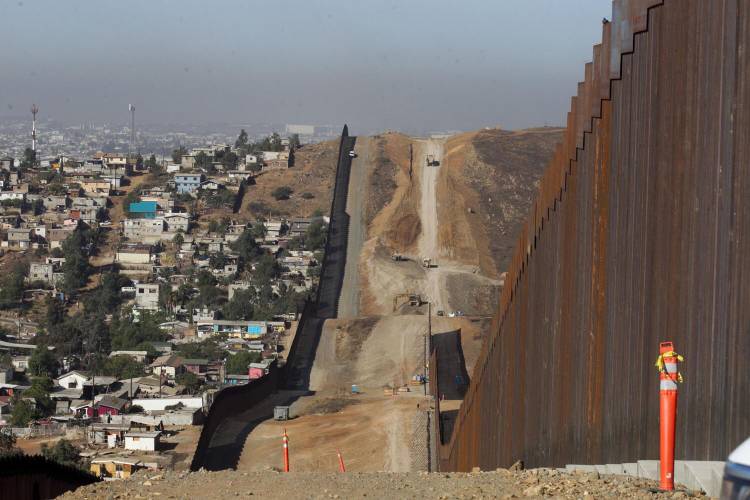My Turn: Is the southern border open?
| Published: 11-23-2023 4:00 PM |
No. The border isn’t open. Not even close. It’s is full of walls and fences, sensors and cameras, patrol cars and helicopters, rivers and mountains. And running this gauntlet is extremely dangerous business that often costs desperate border-crossers their health, limb or even life.
The border is, of course, not fully closed, either. People do manage to cross it illegally without being caught. But then again, absolutely no border in the world is 100% impenetrable — not even the Korean DMZ, the world’s most heavily militarized frontier.
Before the Border Patrol was created in 1924, America did very little to guard its borders. (A few dozen “mounted watchmen” did operate from California to Texas in the first two decades of the century looking for undocumented Chinese nationals). For the next decade, the patrolmen were at least as preoccupied with interdicting alcohol smuggling from Canada as they were with interdicting human smuggling. When they did apprehend and deport undocumented immigrants, they did so in order to protect American workers from unfair competition.
In 1940, just before America entered World War II, the Border Patrol was moved from the Department of Labor to the Department of Justice, and the focus shifted from immigrants-as-cheap-labor to immigrants-as-potential-criminals. After the Sept. 11 attacks, the patrol was incorporated into the newly created Department of Homeland Security, and undocumented immigrants became potential terrorists.
Nowadays, if you’re intent on warning the country about the dangers of undocumented immigration, you go with the full trifecta: immigrants take our jobs, kill us in our homes, and plant bombs in public spaces. None of these things is true, but that of course doesn’t stop politicians, TV commentators and your brother-in-law from saying them.
Somewhere in between the “danger to public safety” and the “terrorist” phases, the state decided to build up the border to stop people from crossing it at will. During the 1980s, two important trends coincided: a big increase in undocumented immigration and the War on Drugs. So the men and women of the Border Patrol began their transformation from guards and policemen who performed arrests to soldiers who ran operations against smugglers and suspected cartel members.
Today, the Patrol has SWAT-like units, helicopters and heavy weapons. It also has the authority to conduct searches within 100 miles of the border (an area which includes most of western Massachusetts).
Somewhat less than half of the 2,000-mile-long southern border is lined with fences and walls, whose construction has advanced steadily, regardless of the party in power, since the 1990s. The rest of the line mostly snakes through harsh terrain: tall mountain ranges, desert and the Rio Grande river. Every segment of the wall that goes up pushes desperate migrants farther and farther into the dangerous areas at ever greater risks to their lives.
Article continues after...
Yesterday's Most Read Articles
But if the border is actually less “open” than it’s ever been, why are so-called “migrant encounters” at the border at a record high? Because people are on the move throughout the world — and particularly in Latin America and the Caribbean — in greater numbers than ever.
President Joe Biden’s Border Patrol is no less busy than Donald Trump’s Border Patrol was, as the “encounter” numbers clearly show.
“This administration expels lots of people,” David Bier, associate director of Immigration Studies at the libertarian-leaning Cato Institute, told me in an interview.
“Some people get through — but some people violate all types of laws and get away with it. Look at the homicide clearance rate: 52%. A higher percentage of people who are arrested crossing the border are expelled than murderers are arrested after committing murder. [Is] the United States open for murder then? The idea that the United States has open borders because not every single person is caught and not every single person who’s caught is expelled is just fantasy land. We don’t have that standard in any other policy discussion,” Bier said.
I posed the same “Is the border open?” question to Nora Gonzalez, a case manager with Casa San José, which is a nonprofit set up by the Catholic Congregation of The Sisters of St. Joseph of Baden to help Latino immigrants.
“I grew up on the border. I was born and raised there in El Paso, Texas, which borders Juárez, Chihuahua. It’s really frustrating to live and work on the border,” Gonzalez said. “But this idea that the border is open is just so untrue. We’re seeing all these headlines about it, when in reality it feels, at least in Texas, [that it’s] increasingly more dangerous for people to attempt to enter the U.S. There are no open gates. There’s not people just coming in like nothing. More obstacles are being put in place for people who come in and ask for asylum. More enforcement and more militarization.”
Migrants are not waltzing into the U.S. They’re risking their lives climbing over walls, swimming across the Rio Grande, crossing the mountain ranges of Arizona and New Mexico, and walking through the Sonoran Desert. According to the International Organization for Migration, a U.N. agency, at least 686 migrants died or disappeared near the Mexico-U.S. border in 2022. The agency calls the border the world’s “deadliest land route for migrants.”
Any reasonable discussion about reducing undocumented immigration must discard the erroneous assumption that the border is “open.” I can offer you the facts, but convincing your brother-in-law to accept them is your job. Happy Thanksgiving!
Razvan Sibii is a senior lecturer of journalism at UMass Amherst. He writes a monthly column on immigration and incarceration. He can be contacted at razvan@umass.edu.



 Guest columnist Gene Stamell: We know what we know
Guest columnist Gene Stamell: We know what we know Michelle Caruso: Questions candidate’s judgment after 1980s police training incident
Michelle Caruso: Questions candidate’s judgment after 1980s police training incident Kathy Sylvester: Vote for expertise on May 6
Kathy Sylvester: Vote for expertise on May 6 Shirley and Mike Majewski: Vote for Blake Gilmore
Shirley and Mike Majewski: Vote for Blake Gilmore
